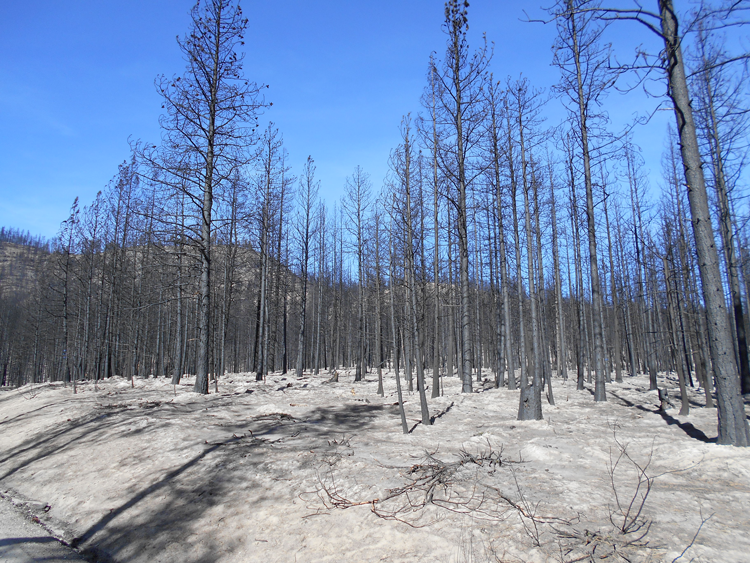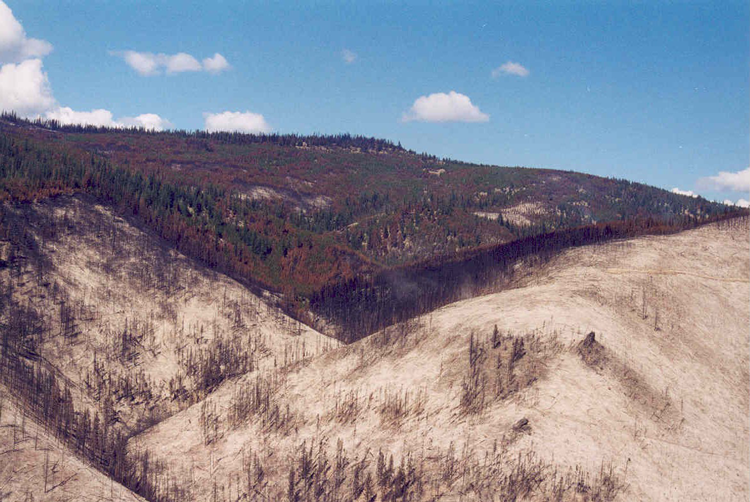Would it make sense to remove dead and dying trees left in a fire’s wake?
“I want to know what you’re going to do about the reburn problem,” the veteran forester said. David Peterson, a new research forester at the U.S. Forest Service Pacific Northwest Research Station’s Wenatchee office, looked up from his desk. “Excuse me, what reburn problem?” Peterson asked.
The man introduced himself as John Townsley, a silviculturist from the Okanogan-Wenatchee National Forest, about 2 hours north of Peterson’s office on the eastern slopes of the Cascade Range in Washington State. The year was 2002 and wildfires were burning through the sites of older wildfires. Resource managers noticed that when these fires reburned areas that had burned in the past 30 or 40 years, the fires could be hard to control and often severely burned the soil.
“These severely burned areas left a big management challenge because there was damage to the soil and increased hazards from flooding and soil erosion. As a silviculturist, Townsley was also concerned about tree regeneration after those fires,” Peterson says
For the next few years, Peterson kept the reburn question on the back burner, so to speak, although Townsley “would come back and bug me about it every year or so,” Peterson says. The silviculturist’s persistence worked, because Peterson started collaborating with other researchers to look into different aspects of the reburn question that would take three studies and several more years to answer.

Two sides of the Cascades
When people think of the Pacific Northwest, perhaps a wet, rainy landscape comes to mind. But the Okanogan-Wenatchee National Forest where Peterson works is part of a drastically different part of the region. The Cascade Range that rises in British Columbia, Canada, and continues south through Washington and Oregon into northern California isn’t just a geologic division; it’s also a meteorological one.
“We’re talking about forests in the rain shadows of the mountains, where every summer is a dry summer,” Peterson says. “We have long fire seasons every year. The forests here are dry and can burn easily if we get lightning storms or human ignitions.”
Winds from the Pacific Ocean carry moist air toward the Cascade Range, where it rises, cools, and produces clouds and precipitation. On the western side of the range, called the windward side, abundant precipitation falls as rain or snow. As the cooler and drier air passes over the Cascades, it warms and dries out, producing a rain shadow on the eastern side of the range.
Landscapes in the rain shadow are typically dry and receive much less precipitation than the windward side of the range.
Unlike western Cascades forests, where centuries can pass between wildfires, wildfires historically occurred every 5 to 40 years in the dry, low-elevation forests of the eastern Cascades. “The fires in these forests were traditionally what we would call low- or mixedseverity fires that mostly burned fuels on the ground,” Peterson says. “These fires are kind of like moving campfires, burning up a bunch of fuel—understory shrubs, dried needles, and wood sitting on the ground—but not killing many trees.”
“Even in the higher elevations where fires are less common,” Peterson says, “mixed-severity fires killed smallish trees or patches of trees, but big trees with thicker bark typically survived.
“Unfortunately, because we’ve done a really good job of putting out most of the fires in these low-elevation dry forests, the fuels build up,” Peterson says. These fuels include dead needles, branches, and logs, as well as smaller trees. All these remain in the forest, ready for the next ignition, and can carry fire from the forest floor up into the treetops.

“You get a mixture of small, medium, and large trees. As fire passes through on the ground, it can climb up these small and mixed-sized trees until it gets into the tree crowns, where all the branches, leaves, and needles are. That’s why we call these ladder fuels,” Peterson says. “If the tree crowns are close together, fires can spread through the tree crowns as well as on the ground, typically killing more trees than surface fires alone.
“Although these crown fires are not unheard of, they used to be fairly rare in the Pacific Northwest’s dry coniferous forests. But we have gotten more and more of these fires,” Peterson says, “thanks to fuel buildups and some severe drought years.”
Would it make sense to remove the snags, the dead and dying trees, left in a fire’s wake through postfire logging to manage the amount of fuels that future wildfires would feed on? Many forest managers felt so, but Peterson was aware that this approach would meet with some resistance. Some might question its fuel reduction benefits or be concerned that it would reduce habitat for wildlife that lived in snags. Others might be concerned about its impacts on forest ecosystem recovery. Still, the question was worth investigating.
Rotten logs and soil heating
About 2 years after his conversation with the Townsley, Peterson collaborated with forest ecology professor Jim Agee and one of his graduate students at the University of Washington in Seattle to look into the effects of salvage logging, or logging trees that have been damaged by wildfire. The student, Philip Monsanto, conducted an experiment to study how reburns would affect soil heating and small tree roots. “The key finding in the study is that rotten logs ignite better and burn longer and more completely than sound logs and therefore have a bigger impact on soil heating,” Peterson says. The study also showed that logs that burned in the later part of the year produced higher surface temperatures and deeper soil heating than those that burned in the spring.

The results suggest that where prescribed fire is introduced to forest stands age 20 to 30 years after wildfire, root heating from smoldering wood can be minimized by burning in spring; removing excess snags early in the postwildfire period could also reduce fuels and soil heating.
Around the time Monsanto was finishing his study, Peterson met with Forest Service colleagues who also wanted to address the reburn question. “We thought, why not take Phil’s basic design and do it at a much larger scale?” Peterson says. The group eventually broke down the reburn problem into additional research questions.
First, the researchers assessed the effects of harvesting fire-killed trees on the accumulation of woody fuels at the study site. “To see if postfire logging could be considered a valid fuel reduction treatment, we needed to compare logged and unlogged sites at a regional scale,” Peterson says.
Short-term pulse, then decline
Peterson and his colleagues created a large dataset by sampling surface woody fuels within 255 coniferous forest stands that burned with high fire severity in 68 wildfires between 1970 and 2007 in eastern Washington and Oregon. The sampling included 96 stands that were logged after wildfires and 159 stands that were not logged. Most of the trees burned in these stands were ponderosa pines or Douglas-firs, two of the most common tree species in low-elevation forests of the eastern Cascades.
The researchers found that without logging, surface woody fuels peaked 10 to 20 years after a fire, as most snags fell or broke. Large, rotten woody fuels increasingly dominated the stands over time, increasing soil heating and smoke production potential during subsequent wildfires.
Compared to unlogged stands, postfire logging produced a short-term (5 to 7 years) increase in small-diameter fuels, mostly from residual logging slash, but then reduced surface fuels over the longer term (10 to 40+ years after fire), particularly in the larger size classes, as more snags fell and became fuel on the unlogged sites than on the logged sites.
They also observed that the amount of fuel generated by decaying snags was related to the number and size of trees killed by fire. This suggested that forest restoration treatments, such as thinning or prescribed burning, could reduce postfire fuel management problems not only by reducing fuels and tree mortality—which is the primary goal—but also by limiting the amount of dead wood generated if all trees are killed.
“The big take home here is that postfire logging can and does serve as a valid fuel reduction treatment. And if done with that goal in mind, it can be very effective,” Peterson says. “If you remove dead trees, you’re reducing future fuels. You can do it badly or you can do it well. But if you do it well, you can have a really big impact on future fuel loadings.”
Probing the understory
Next, the researchers wanted to find out if postfire logging and additional fuel reduction, such as the removal of more logs and snags, would have long-term effects on a forest’s understory vegetation. The researchers sampled 172 plant species in an area burned by the 1996 Summit Fire in northeastern Oregon to see if the postfire logging treatments caused any lasting effects on understory plant cover, species diversity, plant community composition, or exotic species cover.
Peterson and ecologist Erich Dodson with Oregon State University found that postfire logging treatments had no significant effects on understory vegetation cover, diversity, or community composition 15 years after treatment. The researchers say the study demonstrates that understory vegetation can be resilient to postfire logging, particularly when best management practices are used to limit damage to soils.


The researchers noted that more study is needed, however, to confirm the generality of this finding for other forest types and ecosystem components. One recent study has already supported this. Between 2006 and 2012, researchers Eric Knapp and Martin Ritchie of the Pacific Southwest Research Station collected understory richness and cover data in California’s Lassen National Forest, which was recovering from a wildfire in 2002. The researchers found no differences in the richness of both native and nonnative plant species among sites that were logged postfire and those that were not. The findings have also been cited in a guide for forest managers in British Columbia, Canada, in handling several forests burned by wildfires in July 2017.
Peterson and his colleagues’ study on the effects of harvesting his fire-killed trees on the forests’ woody fuels have already provided a scientific basis for forest managers wanting to include fuel reduction in their purpose and needs statement when proposing postfire logging activities in planning documents. For example, fire ecologists in the Rogue RiverSiskiyou National Forest in Oregon used the findings in their guide to postfire salvage operations in the Kalmiopsis Wilderness, which was razed by wildfires in July 2017. The findings were used in an assessment of forest fuels in the Boise National Forest in Idaho and in a fire salvage and restoration report for the Idaho Panhandle National Forests. The study has also been cited in several recent review and synthesis journal papers related to postfire logging, forest restoration, and fire ecology of the Western United States.
“Our research will likely encourage more post-fire logging for fuel reduction, where it is ecologically appropriate,” Peterson says. “It’s comforting to know that if you make some attempt at doing these treatments well, you can do so without having a lot of fear of causing long-term environmental degradation.”
Originally published in Science Findings. Download the publication here.
